What is the ball line defense
The ball line defense is a basketball defensive strategy that implements on-ball defensive pressure and off-ball help defense principles to limit scoring opportunities near the basket while influencing contested perimeter jump shots.
Additionally, the ball line defense is a variation of standard man to man defense and it was also developed by Coach Tubby Smith.
What is an example of the ball line on the court
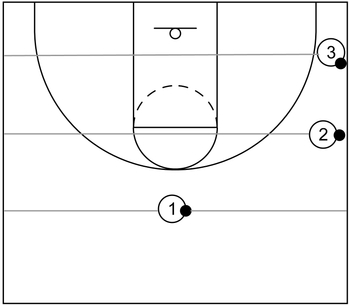
This is an example of what the ball line would look like on the court. Essentially, it is an imaginary line that starts at the location of the ball and then goes through to each sideline.
On the diagram examples, Players 1, 2, and 3 are positioned at the top, the wing, and the corner of the court. Also, each player holds a basketball for demonstrative purposes.
Therefore, three different ball lines are shown at the top, the wing, and the corners, represented by gray lines going from sideline to sideline.
What are general concepts of the ball line defense
Concept #1
The on-ball defender should apply defensive pressure with a hand up near the ball to contest jump shots or limit dribble penetration towards the basket.
Concept #2
Off-ball defenders that are nearest to the ball line should move as close as possible without going too far away from their respective assignments that they are currently guarding.
Also, off-ball defenders, particularly on the weak side, that are further away from the ball line should move towards the basket, particularly in the lane when possible.
Basically, this defensive tactic makes it more difficult for the offensive team to score near the basket, primarily via cutters on the weak side.
Concept #3
Defenders should limit or prevent penetrating passes while encouraging non-penetrating passes.
In the ball line defense, a penetrating pass occurs when an offensive player near one of the perimeter areas at the top, wing, or corner executes a pass towards the basket. For example, if a player on the wing passes the ball into the low post, that would be considered a penetrating pass.
Additionally, if a player passes the ball from the top to the wing, this would also be regarded as a penetrating pass because the ball is still moving closer to the basket.
In other words, the wing area, particularly near free throw line extended, is closer to the basket than the top of the floor where the offense generally gets initiated.
Conversely, a non-penetrating pass occurs when an offensive player executes a pass, typically from the low post area (or near the basket in general) towards the perimeter.
However, if a player executes a pass from the wing to the top, then that could be considered a non-penetrating pass as well because the ball would be going away from the basket.
Concept #4
When the ball is being passed to the wing or corner, the on-ball defender should jump to the ball. This could possibly prevent a face cut to the basket or hinder dribble penetration by the player that receives the ball.
Concept #5
When the ball is above the free throw line extended, the low post defender on strong side should front on the high side.
On the other hand, when the ball is below the free throw line extended (such as in the corner), the low post defender should front on the baseline side.
Concept #6
In the ball line defense, if the ball is near a baseline or corner, the nearest off-ball defender could potentially trap the ball alongside the on-ball defender.
Also, when the trap defense occurs, defenders should use high hands to block the vision of the offensive player with the ball.
Affiliate Disclosure: I may earn a commission on qualifying purchases made through the links below.
What are examples of half court defensive rotations for the ball line defense
Example 1
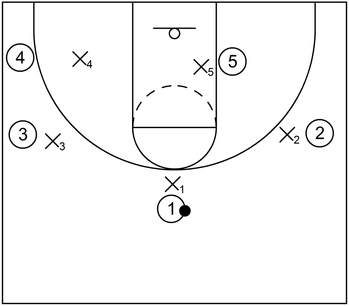
This is an example of the ball line defense when the ball is at the top. It should also be noted that this example and the ones afterwards are based on insights derived from Ball-Line Defense by Tubby Smith.
To start, X1 executes defensive pressure against 1. At the same time, X2 and X3 execute denial defense against 2 and 3 near the wing areas.
X4 could take a step away from 4 near the left corner to provide off-ball help defense in the potential event that 2 or 3 decides to backdoor cut to the basket.
X5 guards against 5 while also emphasizing basket protection as well.
Example 2
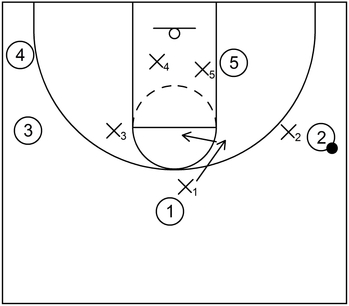
This is an example of the ball line defense when the ball is on the wing. At the start, as 1 executes the pass to the wing, X1 should jump to the ball to prevent the face cut or hinder the middle penetration from the wing.
Afterwards, X1 should immediately slide to the ball line near the high post, which is also referred to as the nail spot, while X2 executes on-ball defense against 2.
X3 can slide towards the left side high post elbow near the ball line while X4 slides into the lane near the basket. Additionally, X5 could front the low post offensive player near the high side, if necessary.
Example 3
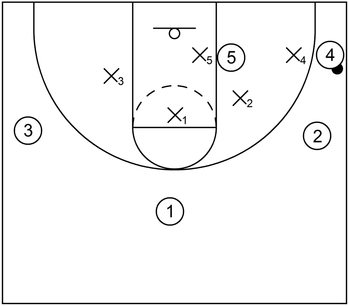
This is an example of the ball line defense when the ball is in the corner. When that occurs, X4 guards against 4 and at the same time, X5 fronts the low post on the low side near the baseline.
X2 moves closer to the ball line by dropping back near the mid-post area on the right side of the lane. This defensive action also prevents middle dribble penetration that could occur by 4.
Additionally, it makes it more challenging for 5 to receive the ball as X2 could potentially steal that entry pass into the post, mainly by way of a deflection or interception.
Furthermore, X1 drops back below the free throw towards the ball line. This also takes away the opportunity to easily cut to the basket for 1.
X3 drops back slightly above the left side low post block close to the ball line. Also, this position for X3 takes away any potential weak side basket cutting opportunities for 3.
Example 4
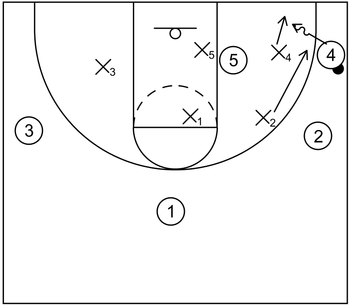
This is an example of a potential baseline trap that could occur in the ball line defense. To start, 4 dribbles baseline in an attempt to get by X4. However, when that occurs, X2 could follow after 4 to set a baseline trap alongside X4.
Also, as that happens, X5 continues to front the low post on the baseline side while X1 continues to cover the area below the free throw line.
Furthermore, X3 continues to cover the weak side as well. From this point, if 4 is able to pass out of the trap, the primary option is 2 but in the ball line defense, this is beneficial because it is a non-penetrating pass.
Example 5
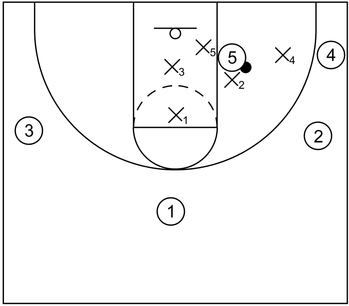
This is an example of the ball line defense if the low post player receives the ball. When that occurs, this triggers an automatic double team by X2 and X5.
In addition to that, X4 could possibly dig at the ball without fouling. The purpose of this defensive action is to influence 5 into executing a non-penetrating pass back towards the perimeter.
Also, X1 and X3 are in the lane as close as possible to the ball line as well to provide additional help if necessary and to prevent cuts to the basket by 1 or 3.